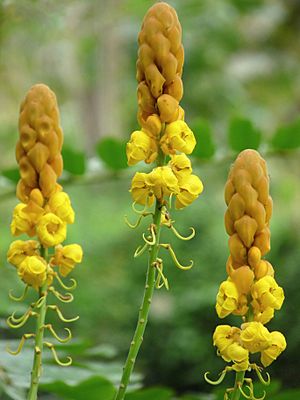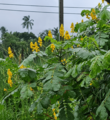Senna alata facts for kids
Quick facts for kids Senna alata |
|
|---|---|
 |
|
| Candle Bush flowers | |
| Conservation status | |
| Scientific classification | |
| Synonyms | |
|
Senna alata is a special plant that is both a medicinal tree and a beautiful flowering plant. It belongs to a group of plants called Caesalpinioideae. People call it by many fun names like emperor's candlesticks, candle bush, Christmas candles, or ringworm shrub. It's a unique type of Senna plant.
Where It Grows
The Senna alata plant comes from warm, tropical parts of the world. You can find it from Mexico and the West Indies all the way down to Paraguay. It grows in many different places, even high up in the mountains, up to 1,200 meters (about 4,000 feet) above sea level.
This plant is very popular in places like Southeast Asia, North Australia, and Africa. It is valued there for its pretty flowers and its uses in medicine. Sometimes, it can grow so well that it spreads quickly and becomes an invasive species in new areas.
What It Looks Like
This plant is a shrub that can grow quite tall, usually between 3 to 4 meters (10 to 13 feet) high. Its leaves are long, about 50 to 80 centimeters (20 to 31 inches) in length.
A cool thing about its leaves is that they close up when it gets dark.
The flowers grow in a way that makes them look like bright yellow candles standing upright. This is why it has names like "candle bush" or "Christmas candles."
After the flowers, the plant grows long, straight pods. These pods can be up to 25 centimeters (10 inches) long. They are dark brown or almost black and about 15 millimeters (0.6 inches) wide. Each pod has a wing on both sides that runs along its entire length. Inside, there are many flat, triangle-shaped seeds, usually between 50 to 60 of them. Water or animals help spread these seeds to new places.
How to Grow It
It's quite easy to grow Senna alata from its seeds. You can plant the seeds directly into the ground where you want them to grow, or you can start them in a special nursery first.
Medicinal Uses
Senna alata is famous for its medicinal properties. One of its most common uses is to treat skin problems like ringworm and other fungal infections. This is why it's often called the "ringworm bush."
To use it, people grind the leaves into a soft, green material. They mix this with a little bit of vegetable oil and rub it on the affected skin two or three times a day. It's best to make a fresh mix each day. The plant has special ingredients, like a yellow substance called chrysophanic acid, that help fight these infections.
The plant also has a natural effect that helps with digestion. This is because it contains certain compounds called anthraquinones.
In the Philippines, Senna alata is known as akapulko. People there use it as both a decorative plant and for its medicinal benefits, especially for its ability to help with digestion and fight fungi.
In Sri Lanka, it's called Ath-thora (ඇත්තෝර) and is used in traditional medicine. In Malaysia, it is known as Gelenggang.
Images for kids
-
S. alata in Malaysia
-
Inflorescences and foliage
-
S. alata in southern Vietnam
See also
 In Spanish: Senna alata para niños
In Spanish: Senna alata para niños








